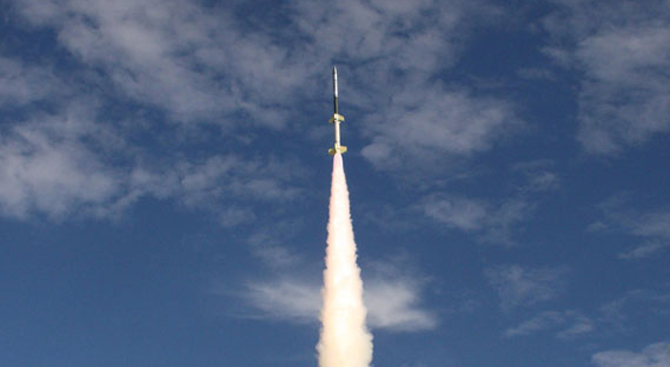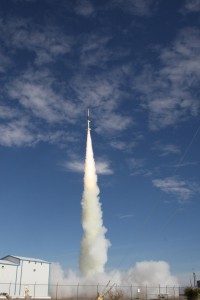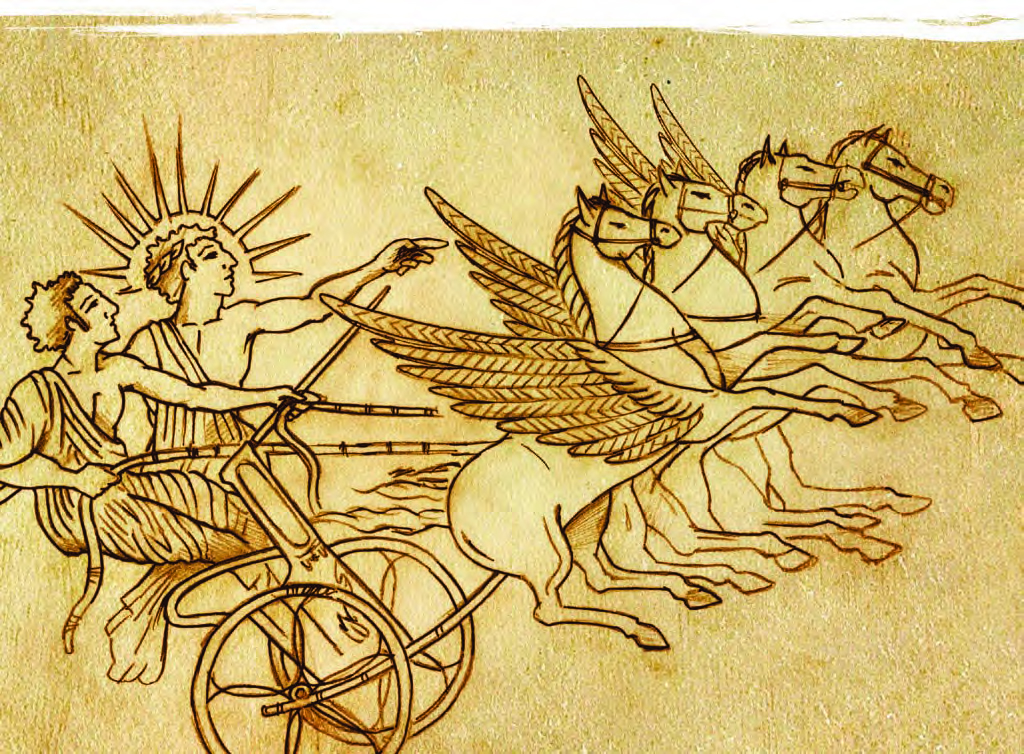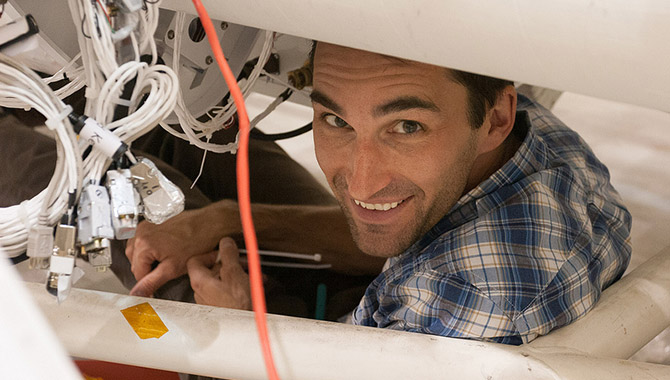
By Don Heyer
In the final days of 2008, the Science Mission Directorate and the Academy of Program/Project and Engineering Leadership released a new opportunity under a fledgling program: the Hands-on Project Experience, or HOPE.

Recent hires who work for the Jet Propulsion Laboratory successfully launched a sounding rocket carrying the TRaiNED project 75 miles above Earth’s surface on Dec. 6, 2010, from the U.S. Army’s White Sands Missile Range in New Mexico.
Photo Credit: White Sands Missile Range
It was described as a “training opportunity” and solicited proposals for small-scale projects from in-house teams of young engineers and scientists. The philosophy behind HOPE was simple: the most effective way to learn how to do something is to actually do it. Only months earlier, management at the Jet Propulsion Laboratory (JPL) had teamed with a group of young employees to form the Phaeton Program around the idea that smallscale flight projects could be used as a tool to rapidly prepare personnel for larger-scale missions. These parallel ideas met in a shared undertaking in early 2009 when TRaiNED (Terrain-Relative Navigation and Employee Development) was selected to become the first HOPE project. I was selected to be the project manager for that project.
The TRaiNED Concept
The HOPE training opportunity requested proposals for a sounding-rocket project that would have a useful purpose for the Science Mission Directorate. Coincidentally, the JPL Phaeton Program had identified a sounding-rocket-based project to develop a technology called “terrain-relative navigation” (TRN) as one of its first projects.
TRN is a technology that could support precision navigation of future spacecraft. One can refine inertial-measurement-based position estimates using computer-vision technology to identify and track features in ground imagery. The objective of this TRN project was to advance the technology’s development by collecting ground imagery, inertial measurement unit data, and GPS data during a sounding-rocket flight and to use that data set to validate TRN through post-flight data processing.
The TRN project presented significant appeal as a training experience. The project would be able to leverage a considerable portion of the technical design from a related sounding-rocket flight flown a few years earlier. The new project would essentially add to and incrementally improve the previous design, keeping the technical scope of the project manageable but challenging. What’s more, most members of the project team from the earlier flight were available and many could act as mentors to the new team. Finally, the program would support the developing project team periodically with short classroom-training modules designed to follow the life cycle of the project.
The pieces fit together nicely, but there was one gaping hole: the program hadn’t identified a way to get the TRN payload onto a sounding rocket. Project HOPE was the solution, and it quickly became clear that the two programs complemented each other nicely.
Implementing TRaiNED
The TRaiNED project was entirely staffed with early-career hires—employees less than three years out of school. These early-career hires were competitively selected at JPL from a large pool of applicants that wasn’t limited to the engineering team: all the project positions were filled with early-career hires. Furthermore, the search for candidates for each position wasn’t limited to those who worked in the related area of the institution. A wider search was conducted to give people who were hired out of school in one discipline an opportunity to gain experience in another.

Project HOPE team members work on the TRaiNED rocket during the assembly and debug processes.
Photo Credit: NASA/Berit Bland
While each member of the project team brought a different background to the table, there were several common learning experiences that we encountered and tackled as one. For example, nobody on the project team had experience writing requirements, yet each individual was responsible for developing the requirements on their own element of the project. There were many different opinions about how to best structure and define these requirements, and these inconsistencies showed through at the project’s system requirements review. This review may not have gone as smoothly as many would have liked, but it served as strong motivation for the team to come together in the following weeks to rework project requirements as a group instead of individually. The result was not only a stronger set of requirements but a more integrated project team.
As TRaiNED was the first HOPE project, there wasn’t any clear model to follow to effectively combine the training and technical goals of the project. Rather, the definition of both programs had to take place in step with definition of the project. At times this was a source of frustration: both programmatic training objectives and project technical objectives had to be accommodated, and these two objectives were sometimes in conflict. Working through these struggles became one of the cornerstone learning experiences for the project team, however, as we were forced to negotiate—as any other project would—the scope and expectations of our work with several stakeholders.
Most of the team quickly learned how many stakeholders they actually had as they started work on their work agreements (WAs)—agreements between the project and line management that describes the work that is to be done and the resources that will be available to complete it. We expected to be able to sail through the WA approval process with relative ease but discovered quite the opposite. In some cases, getting a WA approved became a lengthy process of give and take between the project and the line spanning several weeks. While completing the WAs wasn’t automatic, the conversations they required helped to bring all the stakeholders together with the same understanding of the project’s goals and approach.
In order for the project team to have an authentic hands-on experience, TRaiNED was treated like other flight projects. So, while only a fraction of the size of most flight projects, TRaiNED was planned and structured in the same fashion. Tailoring of the typical processes and requirements was conducted by the project team through normal channels. While there was significant tailoring to reflect TRaiNED’s relatively small scale, the project team experienced firsthand all that goes into planning and executing a project from its conceptual stages through its launch.
Launch
Fast-forward to December 2010. The team that started the project nearly two years earlier is still almost completely intact. During the past two years, we have completed and passed the major project life-cycle reviews; have designed, built, and tested our payload; and worked with a team from Wallops Flight Facility (WFF) to integrate the payload into the sounding rocket that sits on the launcher ready to fly. The JPL, WFF, and White Sands Missile Range teams have gathered in the block house or at other posts around the range and are busying themselves with their prescribed prelaunch tasks. We’ve been here before: once in June when the weather moved in at the last minute and forced the launch to be canceled, and again in September when the weather forecast didn’t even hint at cooperating. After all the prelaunch tests check out, December’s countdown is also placed into a hold because the skies have clouded over. As the launch window nears its end, most people are beginning to resign themselves to another weather cancellation when, with just a few minutes remaining, Dr. Martin Heyne (the TRaiNED principal investigator) announces that there’s been just enough of a clearing in the weather to go for the launch.
If an argument ever had to be made in support of Project HOPE, it was exemplified by the following fifteen minutes. The calm, composed manner in which each member of the project team quickly transitioned from a weather-induced limbo to efficiently executing the final steps of the launch countdown was rewarding to watch and special to be a part of. The collective poise exhibited by the team as the rocket left the rail didn’t exist in 2008. It was poise that could not have come from attending classroom lectures or from reading a stack of books. It came from experience.
Lessons Learned and Suggestions for Future Projects
Two more HOPE projects are currently under way, and with any luck their success will mean more to follow. Now that a few months have passed since the TRaiNED launch, I’ve had a chance to consider what helped make TRaiNED a success. While the following list is in no way comprehensive, I’d like to highlight four factors that I found to be of particular importance.
- Project Selection. The selection of an achievable concept is critical. The project has to be challenging enough to be worthwhile, but manageable enough so that the project team can divide their attention between solving technical problems and learning about how a flight project is executed. Learning how to execute a flight project, let alone actually doing it, is time consuming and easy to underestimate.
- Institutional Support. JPL provided us with a phenomenal level of support throughout the project. The institutional investment in a program to help direct and shepherd along this project and others like it was invaluable.
- Review Board Selection. It is important to convene a standing review board that recognizes the developmental nature of the project, but will still give objective feedback where the project demonstrates weaknesses. The standing review board assembled by Project HOPE for TRaiNED was an asset throughout the project. The TRaiNED standing review board not only helped us identify weaknesses in the project and correct them, but helped coach us so that we were better prepared for the next review.
- Mentors. Mentoring was critical to the success of the TRaiNED project. We were fortunate enough to have a team of engaged mentors who routinely took time out of their schedule to help us with whatever problem we happened to be facing that particular day. Most importantly, our mentors were invaluable in identifying upcoming problems that we weren’t even aware existed. I lost count of how many times they asked me, Have you thought about XYZ? I invariably realized that I hadn’t but needed to.
About the Author
| Don Heyer is an electrical engineer in the flight communications section at the Jet Propulsion Laboratory. He is currently working on the ExoMars Trace Gas Orbiter project, and he is the project manager for TRaiNED. |









